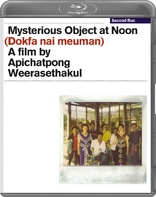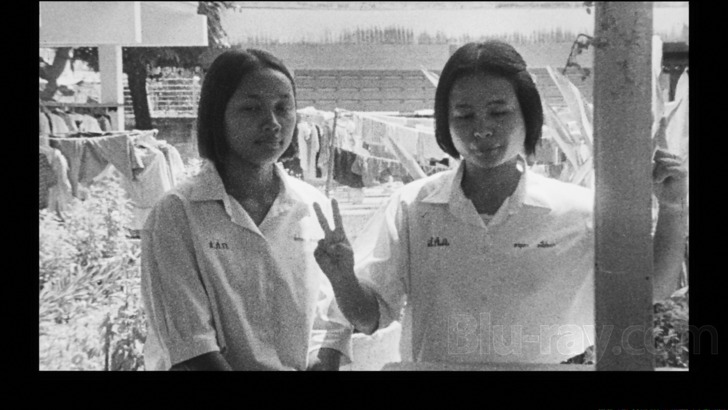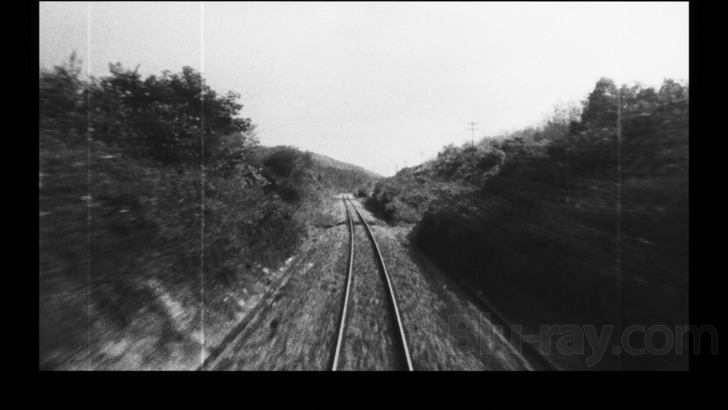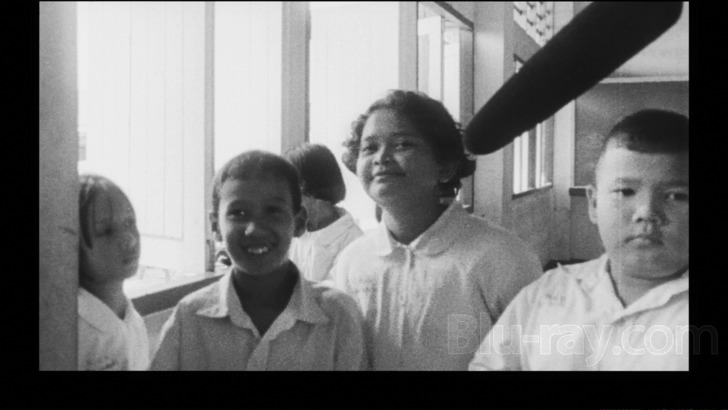Mysterious Object at Noon Blu-ray Movie
HomeMysterious Object at Noon Blu-ray Movie 
ดอกฟ้าในมือมาร / Dokfa nai meumanSecond Run | 2000 | 85 min | Rated BBFC: PG | Apr 25, 2016

Movie rating
6.1 | / 10 |
Blu-ray rating
| Users | 0.0 | |
| Reviewer | 3.5 | |
| Overall | 3.5 |
Overview
Mysterious Object at Noon (2000)
A film crew travels from the Thai countryside to Bangkok, asking the people they encounter along the way to continue a story about a handicapped boy and his teacher.
Starring: Djuangjai Hirunsri, Kongkiat Khomsiri, Saisiri XoomsaiDirector: Apichatpong Weerasethakul
| Foreign | Uncertain |
| Drama | Uncertain |
| Documentary | Uncertain |
| Surreal | Uncertain |
| Mystery | Uncertain |
Specifications
Video
Video codec: MPEG-4 AVC
Video resolution: 1080p
Aspect ratio: 1.76:1
Original aspect ratio: 1.37:1
Audio
Thai: DTS-HD Master Audio 5.1 (48kHz, 24-bit)
Thai: LPCM 2.0
Subtitles
English
Discs
50GB Blu-ray Disc
Single disc (1 BD)
Playback
Region free
Review
Rating summary
| Movie | 3.5 | |
| Video | 3.5 | |
| Audio | 3.5 | |
| Extras | 2.0 | |
| Overall | 3.5 |
Mysterious Object at Noon Blu-ray Movie Review
Reviewed by Jeffrey Kauffman March 20, 2020Kind of ironically (and sadly), just as I was beginning to write this review of a film done by a winner of the Palme d'Or, a Variety article came across my news feed announcing that this year's Cannes Festival has been at the very least postponed if not outright cancelled due to fears over the Corona virus pandemic. We may have to wait a while to see who takes home this year’s prize (if one is even awarded), but the Palme d’Or has long been one of the most sought after awards in the entire global film industry, and a cursory list of some of the films which have taken it home reads like a “who’s who” of all time cinematic greats, along with a few potential head scratchers: Rome, Open City, Brief Encounter , The Lost Weekend (all three of the preceding feted in 1945, one of the years which saw multiple winners announced), The Third Man, The Wages of Fear, Marty, Friendly Persuasion (one of those potential head scratchers), Black Orpheus, The Leopard, The Umbrellas of Cherbourg, The Knack... and How to Get It (another potential head scratcher), A Man and a Woman , Blow-Up, M*A*S*H, The Go-Between, The Conversation, Taxi Driver, The Tree of Wooden Clogs, Apocalypse Now, All That Jazz, Kagemusha (these two preceding also sharing an award year) and Pulp Fiction are just some of the better remembered titles so honored through the years. Among the lesser remembered titles to win the Palme d'Or might be 2010's winner, Uncle Boonmee Who Can Recall His Past Lives, the work of Thai filmmaker Apichatpong Weerasethakul. Mysterious Object at Noon was Weerasethakul's debut as a feature film director, and it offers what the back cover of this release touts as "an extraordinary mix of experimental documentary and fiction" which is also described (probably accurately) as being "hallucinatory".

Maybe some of you experienced a little game in school that I still remember one of my grade school teachers foisted off on us: she had a student write the opening sentence of a story, then handed that sentence to a second student, who was tasked with writing a follow-up sentence. Then she moved on to a third student, who could only see the second student’s sentence and had to add to it. This process continued until all 25 or so kids in the class had written one sentence ostensibly linked to the one before it, and at the point the teacher shared the “story” we had supposedly written. It was often nonsensical and had several logical inconsistencies (I still remember the focal character kept changing genders, maybe in a “precog” of Orlando), but it was kind of weirdly hilarious. There’s not much hilarity on tap in Mysterious Object in Noon, but in a similar way Weerasethakul crafts Mysterious Object at Noon out of interchanges with a variety of people found across Thailand who are tasked with continuing a “story” initially offered as a follow up anecdote to a story which is assumedly a “real” tale from that person’s past.
As such, Mysterious Object at Noon doesn’t really make “sense” in a traditional way, and it is often a patently bizarre blend of a kind of verité ambience mixed with an almost magical realist underpinning that is certainly sui generis. I’m frankly not sure the film entirely works or even hangs together very well, but that may be part of its kind of rough edged charm. It certainly offers an almost carnival-esque careening through various nooks and crannies (and frighteningly narrow alleyways stuffed with people, often on motorcycles) of Thailand.
Mysterious Object at Noon Blu-ray Movie, Video Quality 

Mysterious Object at Noon is presented on Blu-ray courtesy of Second Run with an AVC encoded 1080p transfer in 1.76:1 (rather oddly windowboxed, as can be made out in the screenshots accompanying this review, though the second text block below has some explanation in that regard). Second Run provides quite a bit of technical information on the restoration and transfer. The first information comes courtesy of a text card at the beginning of the presentation which states:
Mysterious Object at Noon was made in 1999. In 2012/13, the film was restored by the World Cinema Foundation and the Austrian Film Museum, using the 35mm duplicate negative with burned in subtitles deposited at the film museum by Apichatpong Weerasethakul. The negative was struck in 1999 from the (now lost) 16mm camera reversal element.Even more detailed technical information is found in the release's insert booklet, which has this to add (and the text below is not even the sum total of what's in the insert booklet):
The duplicate negative was scanned at 3K and digitally restored at the Austrian Film Museum. Painstaking work was undertaken to remove dust, scratches and other visible marks while keeping the look (and specific defects) of the original 16mm camera reversal material intact. The subtitles were sharpened and corrected where necessary.
Color correction was carried out at LISTO laboratory in Vienna; the 35mm optical soundtrack negative was transferred at L'Immagine Ritrovata in Bologna; digital sound restoration was performed at Technicolor Ltd in Bangkok.
The restoration was carried out in close collaboration with the filmmaker and completed in June 2013. The process produced a new 35mm internegative, preserved at the Austrian Film Museum.
Mysterious Object at Noon was shot on 16mm black and white reversal film stock and subsequently blown up to 35mm for theatrical release. The 16mm original camera reversal print no longer exists. The restoration therefore drew on the best surviving element - the 35mm blow up internegative. Apichatpong Weerasethakul had deposited this negative with the Austrian Film Museum in 2007. In 2015, it was repatriated and is now held at the Thai Film Archive in Bangkok.All of the above obviously reflects commendably on the care and effort that was taken to restore Mysterious Object at Noon, but as might be gleaned both from the less than optimal element utilized, as well as some of the choices made to leave some of the anomalies intact mean this presentation has some deficits which frankly can't be ignored. As can be seen quite clearly in some of the screenshots accompanying this review, the restoration gauntlet perhaps unexpectedly has left several pretty significant signs of age related wear and tear, including some relatively long lasting and obvious scratches and other blemishes. Due to the smaller millimeter format, fine detail levels and an at times pretty chunky looking grain field simply need to be accepted at face value, but when the camera is stationary and close-ups are featured, things actually look rather good, helped by generally consistent contrast that offers some appealingly deep blacks and nicely modulated gray scale. I'm officially scoring this at 3.5 at least in part to temper expectations, but I'd probably nudge this up toward 3.75 territory if I were able to.
The Austrian Film Museum scanned the negative at 3K resolution (3072 x 2160 pixels) and a bit depth of 10-bit (logarithmic scale) on its own ARRISCAN ideally suited to archival film elements. The aim of the ensuing digital image restoration was to remove, as best as possible, the ravages of time upon the negative without correcting any inherent defects stemming from the films' [sic] original production circumstances. Its characteristic "grainy" look was therefore retained, while printing errors such as repeated frames or jump cuts were deliberately untouched. Another attribute of the source material that was not corrected were the English subtitles that were ingrained on the negative at the time of its creation. Rather than attempt to remove the subtitles digitally, which ran the risk of introducing unwanted visual 'artifacts', it was decided to retain them as a permanent reminder of the film's suboptimal survival status. At the request of director Apichatpong Weerasethakul, the subtitles were corrected and enhanced where necessary.
Digital colour grading was carried out that the Listo Videofilm laboratory in Vienna under the personal supervision of Apichatpong Weerasethakul. As with the digital image restoration, no attempt was made to rectify the "overexposed" look of the original film. Listo also handled the printing and processing of the new analog preservation and access elements.
As the original DAT master tapes could not be located, the 35mm optical soundtrack negative served as the source for the sound restoration. The soundtrack negatives were digitised at 24-bit/48kHz at the specialised film restoration laboratory L'Immagine Ritrovata in Bologna on a Sondor OMA E fitted with COSP-Xi 2K. Sound restoration was carried out at Technicolor Thailand, Ltd., during which the original Dolby Stereo track was remixed into a more contemporary 5.1 surround sound configuration.
Once all restoration had been completed, new 35mm image and soundtrack negatives were created for optimum long term preservation. From these negatives, new 35mm prints were struck to facilitate continued access to the film in its original presentation format. At the same time, 2K and 4K Digital Cinema Packages were produced for modern digital theatrical presentation.
On this disc, Mysterious Object at Noon is presented in its original 1.78:1 aspect ratio [sic]. To accommodate the English subtitles which were party printed outside the image borders, the picture has been window-boxed slightly on the bottom, left and right sides.
Note: This is a region free release and played without any problems on my Region A equipment.
Mysterious Object at Noon Blu-ray Movie, Audio Quality 

Mysterious Object at Noon features DTS-HD Master Audio 5.1 and LPCM 2.0 tracks in the original Thai with forced English subtitles, as per the technical data quoted above in the video section of the review. I'm frankly not sure this film really "needed" a surround repurposing, but there is at least a marginal opening up of the soundstage when Weerasethakul and his crew are marauding through various outdoor environments. Dialogue (if it can appropriately be termed that) is generally clear, though occasionally some of the background clamor in the outdoor material can slightly mask individual moments.
Mysterious Object at Noon Blu-ray Movie, Special Features and Extras 

- Nimit (Meteorites) (576i; 15:54) is a 2007 short film by Apichatpong Weerasethakul.
- Apichatpong Weerasethakul in Conversation with Mehelli Modi (1080p; 26:40)
- About the Restoration (720p; 7:09) features Matteo Lepore.
Mysterious Object at Noon Blu-ray Movie, Overall Score and Recommendation 

The fact that Apichatpong Weerasethakul took home the Palme d'Or in 2010 may be as indicative as anything as to how much his reputation has grown since the advent of Mysterious Object at Noon. There's truly nothing quite like this film (at least in my personal viewing experience), and so on that level alone some devoted World Cinema enthusiasts will probably want to at least check this thing out, even if it doesn't immediately go on to the "rewatch as soon as possible" pile. There has obviously been enormous effort undertaken to restore the image quality here, but those heroic efforts have only been able to do so much with what Second Sight itself states is a "suboptimal survival status" for the film. With caveats noted, and with an understanding that this is certainly not a film for everyone, Mysterious Object at Noon comes Recommended.
Similar titles
Similar titles you might also like

Revenge
Месть / Mest' / The Red Flute | Masters of Cinema
1989

Insiang
1976

Dry Summer
Susuz Yaz / Reflections / Masters of Cinema
1963

Pather Panchali
পথের পাঁচালী / Song of the Little Road
1955

Cemetery of Splendour
รักที่ขอนแก่น / Rak ti Khon Kaen
2015

Evil Does Not Exist
悪は存在しない
2023

Neon Bull
Boi Neon
2015

A Ship Bound for India
Skepp till India land
1947

Winter Light
Nattvardsgästerna
1963

Le Testament d'Orphée
Testament of Orpheus
1960

Dekalog
The Decalogue I-X
1989

Burning
버닝 / Beoning
2018

Manila in the Claws of Light
Maynila, sa mga Kuko ng Liwanag
1975

Aparajito
অপরাজিত / The Unvanquished
1956

Apur Sansar
অপুর সংসার / The World of Apu
1959

Theorem
Teorema
1968

The Wild Pear Tree
Ahlat Ağacı
2018

The Big City
Mahanagar
1963

Mademoiselle
1966

The Rocket
2013